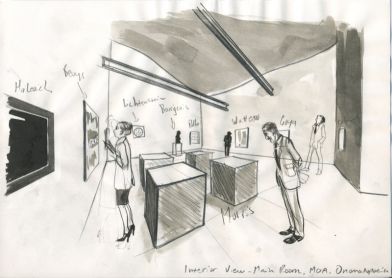AVERY – MORTON – PERROTIN
Galerie Perrotin is delighted to announce “It Means It Means!”, an exhibition by Charles Avery, curated by Tom Morton, from 22nd of June to 27nd of July 2013.
“It Means It Means!” is a ‘drawn group exhibition’ that will be staged in two locations simultaneously – once as a fiction, once as a fact. The first location is the Museum of Art Onomatopoeia on ‘The Island’, a fictional realm that has provided the backdrop to the British Artist Charles Avery’s artistic and philosophical investigations since 2005. The second location is Galerie Perrotin, Paris.
The curator Tom Morton has been given plans of Avery’s fictional museum, for which he has devised an exhibition comprised of real works by real artists, ranging from Antoine Watteau to Tino Sehgal. Entitled ‘It Means It Means!’ this exhibition may only be witnessed through a series of large, highly detailed drawings, made by Avery in response to Morton’s selection and placement of works, and presented at Galerie Perrotin. This project, then, is not only an example of what André Malraux termed a ‘Musée Imaginaire’, but is also an exploration (among other things) of what constitutes a site for artistic and curatorial production, and of the artist/curator relationship. If the show customarily contains the artwork, might the artwork also contain the show?
“It Means It Means!” is an exhibition that circumvents almost all of the customary processes and paraphernalia of exhibition making. A ‘drawn group show’ does not demand loan agreements, shipping contractors, or teams of technicians – all that is necessary to its creation is a list of works, supplied by the curator, and Avery’s efforts at the drawing board. If freedom from budgetary constraints means that the exhibition might conceivably contain any artwork from anywhere in the ‘real’ world (compare the costs of transporting, say, a large bronze sculpture across an ocean to depicting it in pencil on paper), the fact that it will be staged in a fictional museum, in the capital city of a fictional territory, gives rise to further freedoms, perhaps among them the suspension of certain curatorial orthodoxies. To encounter Avery’s drawings of ‘It Means It Means!’ in Perrotin’s space is to encounter an exhibition that contains an exhibition, and a series of artworks that contains a series of artworks. The real, here, is displaced into the fictional, and the fictional into the real.
The exhibition’s title might be understood as a response to a question often it mean?’ To state that ‘It Means It Means!’ is to draw attention to an artwork’s primary property, the fact that it ‘means’ before it ‘denotes X’ or ‘connotes Y’. Perhaps it is only when artworks from our own world travel to another that this property comes into focus. This exhibition at The Island’s Museum of Art is, after all, a showcase of exotica – a wildly circumscribed crash-course in foreign art made after a very foreign Enlightenment. Might the Islanders understand these works as we do, or might they take them in a very different spirit? And what, we might wonder, is shown at the Museum of Art Onomatopoeia, when it is not playing host to artworks produced far from the Island’s shores?
‘It Means It Means’ features many works drawn from ‘our’ art history that speak to the Islanders project’s iconography and conceptual concerns. Accordingly, the visitor will encounter waves, clouds and air (Celmins, Lozano, Riley, Constable, Stieglitz, Art & Language, Hiorns); circles and spheres (Ray, Lichtenstein, Hesse, Hammons); squares and cubes (Malevich, LeWitt, Morris); pairs of lovers, friends, rivals and doubles (Abramovic & Ulay, Gonzalez-Torres, Watteau, Duchamp, Beuys, Sturtevant); the short-circuiting of numeric and linguistic logic (Polke, Sehgal, Parreno); and several instances of ‘dogs in art’ (Balla, Bourgeois, Goya, Koons). In the Museum’s piazza, temporarily ‘relocated’ from the United Nations Building, New York, will stand Barbara Hepworth’s monumental “Single Form” (1961-4). The presence of this sculpture in the city of Onomatopoeia may be read as a gesture of friendship and goodwill between our world and the world of The Island, between the real and the fictive.
List of featured artists: Marina Abramovic & Ulay; Art & Language; Giacomo Balla; Joseph Beuys; Louise Bourgeois; Vija Celmins; Marcel Duchamp; Caspar David Friedrich; Félix Gonzàlez-Torres; Francisco de Goya; Eva Hesse; Roger Hiorns; David Hammons; Barbara Hepworth; Jeff Koons; Sol LeWitt; Roy Lichtenstein; Lee Lozano; Kazimir Malevich; Robert Morris; Philippe Parreno; Sigmar Polke; Charles Ray; Bridget Riley; Tino Sehgal; Alfred Stieglitz; Sturtevant; Antoine Watteau.
Exhibition organized on the occasion of The Nouvelles Vagues season at the Palais de Tokyo with the support of the Comité professional des galeries d’art.
Charles Avery Biography
Charles Avery (b.1973, lives and works in London and Mull, UK) has had solo exhibitions at: GEM, Den Haag (forthcoming 2014); FRAC Ile-de-France Le Plateau Paris, Kunstverein Hanover, EX3 Florence (2010); Parasol Unit London, National Gallery of Modern Art Edinburgh, Museum Boijmans Van Beuningen Rotterdam (2008). He represented Scotland at the 52nd Venice Biennale (2007), and has participated in numerous major group exhibitions, including “British Art Show 7” (2010-11), “Altermodern: Fourth Tate Triennial” (2009, curated by Nicolas Bourriaud), and the 2007 Lyon and Athens Bienniales.
Tom Morton Biography
Tom Morton (b.1977) is a London-based curator, writer, and Contributing Editor of frieze. He was co-curator of the quintennial travelling exhibition “British Art Show 7” (2010-2011), and has worked as a curator at the Hayward Gallery (2008-11) and Cubitt Gallery, London (2006-7). He was co-curator of the 2008 Busan Biennale, and curated the exhibition How to Endure for the 2007 Athens Biennial. In late 2013, he will co-curate a survey of recent British and Polish art at the CSW Ujadowski Castle, Warsaw. Morton’s writing has appeared in numerous exhibition catalogues, and in journals including frieze, Frog, Bidoun, and Metropolis M.
Press
